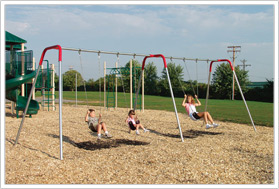

Swings

Swings or swing sets are a popular play fixture found on most playgrounds throughout the world. Swings provide children with a fun-filled sensation as they glide to and fro on units made of steel or wood. In fact, swings have been around for many centuries and have been depicted in classical art throughout the ages. In early times, swings could be found hanging from tree limbs. Over the years, and with the formation of Consumer Product Safety Commission (CPSC) guidelines, swings have evolved with safety in mind. Safety guidelines dictate that the swings fall zone (area free from other objects) shall be 2 times the height of the top in front and behind the swing. Given this fact, a swings fall zone occupies a large area. When selecting your swing, keep this fact in mind.
When selecting your swing, also consider the age of the child. The older the child, the higher the swing's top rail. The top rail height is measured from the ground to the cross bar that supports the swings. Also, as the age of the child increases, so too should the steel post diameter. Older children (classified as 5-12) and adults are easily accommodated on swings that feature a top rail of 3.5" O.D. at a height of 10-12'. Additionally, the swing should employ three support legs (called a Tripod) rather than a Bipod. The Tripod configuration will provide greater support and less motion when used by older children and adults.
A Bipod swing featuring a top rail measuring 2 3/8" O.D. with heights of 8' will accommodate younger children classified as 2-5 years of age. Single post swings provide a sleek look and are better suited for younger children.
The swing fall zone is a very important consideration. Equally important is the location of the swing set in relation to the other structures in the play environment. The CPSC recommends that swings be placed away from other play activities. Such placement is encouraged to reduce the chance of children crossing the path of the swing's motion arch. Many accidents occur when a child crosses the path of a swing in motion. Calculating a swing fall zone is very easy. In the back and forth area (swing motion-front and behind) you must maintain a space that is 2 x the height of the top rail. If the top rail is 10' tall, the space required is 20' in front and 20' behind for a total of 40'. In the side-to-side area, you follow the standard requirement of 6' on either side of the swing. If the swing is 20' wide, you add 6' feet to each side for a total of 32'. The total fall zone for the swing used in this example is 40' x 32'. This total area must have a safety surface that meets the CPSC requirements for impact attenuation.


